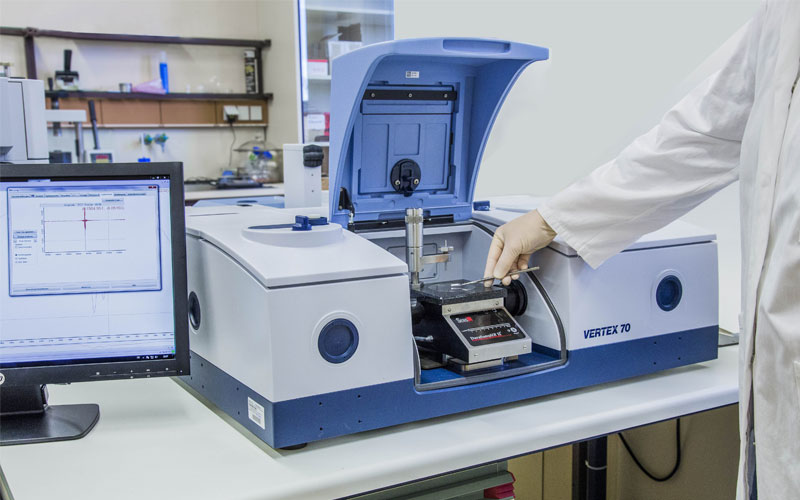Fourier Transform Infrared (FTIR) spectroscopy helps scientists figure out what things are made of on a tiny molecular level. It’s changed the game in chemistry, materials science, and biochemistry, giving scientists a powerful way to peek into the hidden world of molecules and learn amazing things.
FTIR spectroscopy utilizes the interaction of infrared radiation with matter, providing a detailed fingerprint of molecular vibrations. This article will delve into the principles of FTIR spectroscopy, the components of FTIR instruments, and how this technique allows you to probe molecular structure and composition with precision.
Understanding FTIR Spectroscopy
FTIR spectroscopy works by using infrared light. This is to study how molecules move and vibrate. Molecules have their own special frequencies at which they absorb this type of light. Also, it’s all tied to the way their bonds and structure are set up.
The molecules in that substance soak up particular types of light, creating peaks on a special graph called the FTIR spectrum. Each peak shows a different way the molecules are vibrating, telling you about the parts and makeup of the molecules in the substance.
Components of FTIR Instruments
Fourier Transform Infrared (FTIR) spectroscopy is a powerful tool for probing molecular structure and composition. Here are the key components that make up an FTIR instrument and how they collectively contribute to precise molecular analysis.
1. Source
The source in an FTIR instrument generates infrared radiation. Common sources include globar (silicon carbide) or a blackbody radiator, emitting a wide range of infrared wavelengths.
2. Interferometer
The heart of an FTIR instrument is the interferometer, which modulates the infrared beam and facilitates the transformation of the interferogram into a spectrum. The Michelson interferometer is a widely used type in FTIR instruments.
3. Sample Compartment
The sample compartment holds the sample being analyzed. The sample is placed in a cell or holder to ensure precise and consistent measurements.
4. Detector
The detector receives the modulated infrared beam and converts it into an electrical signal. Modern FTIR instruments often use highly sensitive detectors like mercury cadmium telluride (MCT) or deuterated triglycine sulfate (DTGS).
5. Computer System and Software
The computer system processes the electrical signal from the detector and performs a Fourier transformation to convert the interferogram into a spectrum. Advanced software helps analyze and interpret the resulting FTIR spectrum.
Analyzing Molecular Structure and Composition
Agilent FTIR spectroscopy instruments, for instance, allow scientists to gain a deeper understanding of molecular structure and composition in a non-destructive and quantitative manner. Here’s how FTIR spectroscopy provides precise insights:
1. Functional Group Analysis
FTIR spectroscopy excels at identifying and quantifying various functional groups within a molecule. By analyzing the positions and intensities of these peaks, researchers can determine the types and amounts of functional groups present, which provide critical information about the molecular structure.
2. Polymer Characterization
FTIR spectroscopy is widely used in polymer science to study polymer composition, degree of polymerization, and structural defects. The technique can distinguish between different types of polymers and detect subtle changes in their molecular structure, aiding in material quality control and development.
3. Probing Molecular Bonds
FTIR spectroscopy can identify and quantify bond types like C-H, N-H, O-H, and C=O bonds. This allows researchers to understand the bonding environment within molecules, providing insights into their molecular structure.
4. Quantitative Analysis
FTIR spectroscopy can be utilized for quantitative analysis by comparing the intensities of absorption peaks with known concentrations of standard samples. This calibration facilitates the determination of the concentration of specific components within a mixture, making FTIR a valuable tool for analytical chemistry and pharmaceutical industries.
5. Biomedical Applications
FTIR spectroscopy has gained prominence in biomedical research for analyzing biological tissues and fluids. It allows for the identification of disease markers, assessment of tissue composition, and characterization of biomolecules.
The Transformative Power of FTIR Spectroscopy
Imagine Fourier Transform Infrared (FTIR) spectroscopy as a super microscope for molecules! It’s changed the game in how you explore the tiny world of molecular makeup. This technique uses the idea that molecules vibrate in their unique ways and soak up certain kinds of infrared light.
FTIR spectroscopy isn’t just limited to one field—it’s a versatile tool. Scientists and industry experts use it to unlock the mysteries of various things. With FTIR, you’re diving deep into the microscopic world, and the insights you gain help you make amazing strides in research and technology.

















